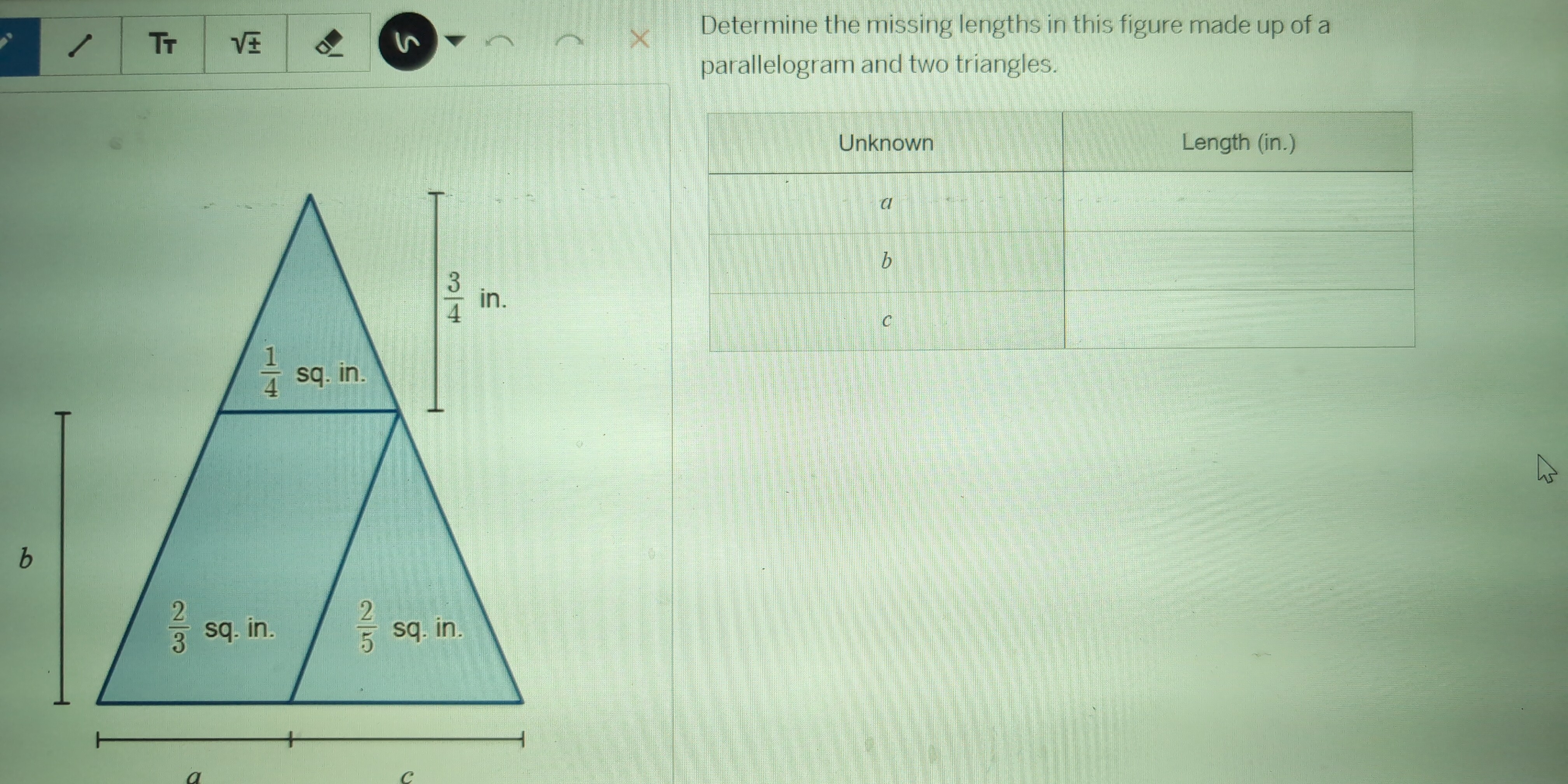Determine the missing lengths in this figure made up of a parallelogram and two triangles.

Understand the Problem
The question is asking to determine the missing lengths represented by variables a, b, and c in a geometric figure that consists of a parallelogram and two triangles, using the given area measurements.
Answer
a = $\frac{2}{3}$ in., b = $\frac{8}{9}$ in., c = $\frac{8}{15}$ in.
Answer for screen readers
The missing lengths are:
- ( a = \frac{2}{3} ) in.
- ( b = \frac{8}{9} ) in.
- ( c = \frac{8}{15} ) in.
Steps to Solve
-
Determine the total area of the triangles The total area of the top triangle and the bottom triangle can be calculated by adding the given areas: $$ \text{Total Area} = \frac{1}{4} + \frac{2}{3} + \frac{2}{5} $$
-
Find a common denominator To sum these fractions, we need a common denominator. The least common multiple of 4, 3, and 5 is 60.
Convert each fraction:
- $$ \frac{1}{4} = \frac{15}{60} $$
- $$ \frac{2}{3} = \frac{40}{60} $$
- $$ \frac{2}{5} = \frac{24}{60} $$
-
Calculate the total area Now sum the converted fractions: $$ \frac{15}{60} + \frac{40}{60} + \frac{24}{60} = \frac{15 + 40 + 24}{60} = \frac{79}{60} $$
-
Calculate the height of the triangles Because the height of the triangles is given as ( \frac{3}{4} ) in., we can use this to find the values of ( a ), ( b ), and ( c ).
-
Solving for the base using the area formula For the area of a triangle: $$ \text{Area} = \frac{1}{2} \times \text{base} \times \text{height} $$ We set our area equal to the calculated area for both triangles.
For the triangle with area ( \frac{1}{4} ): $$ \frac{1}{4} = \frac{1}{2} \times a \times \frac{3}{4} $$ Solving for ( a ): $$ a = \frac{1/4 \times 2}{(3/4)} = \frac{2}{3} $$
- Solve for ( b ) and ( c ) similarly Using the area formulas similarly for the other areas: For ( b ) with: $$ b = \frac{2/3 \times 2}{(3/4)} = \frac{8}{9} $$
And for ( c ) with: $$ c = \frac{2/5 \times 2}{(3/4)} = \frac{8}{15} $$
The missing lengths are:
- ( a = \frac{2}{3} ) in.
- ( b = \frac{8}{9} ) in.
- ( c = \frac{8}{15} ) in.
More Information
The calculations involve determining the areas of triangles and then reversing the area formula to find the base lengths. Each piece of the triangle contributes to the overall shape's dimensions.
Tips
- Forgetting to use a common denominator when adding fractions.
- Misapplying the formula for area by using incorrect dimensions.
- Confusing the base and height in the area formula.
AI-generated content may contain errors. Please verify critical information